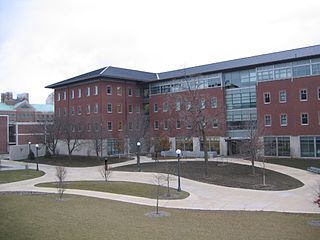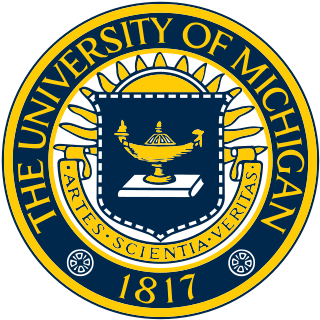
The National Center for Supercomputing Applications (NCSA) is a state-federal partnership to develop and deploy national-scale cyberinfrastructure that advances research, science and engineering based in the United States. NCSA operates as a unit of the University of Illinois Urbana-Champaign, and provides high-performance computing resources to researchers across the country. Support for NCSA comes from the National Science Foundation, the state of Illinois, the University of Illinois, business and industry partners, and other federal agencies.

David A. Bader is a Distinguished Professor and Director of the Institute for Data Science at the New Jersey Institute of Technology. Previously, he served as the Chair of the Georgia Institute of Technology School of Computational Science & Engineering, where he was also a founding professor, and the executive director of High-Performance Computing at the Georgia Tech College of Computing. In 2007, he was named the first director of the Sony Toshiba IBM Center of Competence for the Cell Processor at Georgia Tech.
United States federal research funders use the term cyberinfrastructure to describe research environments that support advanced data acquisition, data storage, data management, data integration, data mining, data visualization and other computing and information processing services distributed over the Internet beyond the scope of a single institution. In scientific usage, cyberinfrastructure is a technological and sociological solution to the problem of efficiently connecting laboratories, data, computers, and people with the goal of enabling derivation of novel scientific theories and knowledge.

The University of Michigan College of Engineering is the engineering college of the University of Michigan, a public research university in Ann Arbor, Michigan.

Arden Lee Bement Jr. is an American engineer and scientist and has served in executive positions in government, industry and academia.
Vasant G. Honavar is an Indian-American computer scientist, and artificial intelligence, machine learning, big data, data science, causal inference, knowledge representation, bioinformatics and health informatics researcher and professor.
The University of Michigan School of Information is the informatics and information science school of the University of Michigan, a public research university in Ann Arbor, Michigan. It offers baccalaureate, magisterial, and doctoral degrees.
Computational informatics is a subfield of informatics that emphasizes issues in the design of computing solutions rather than its underlying infrastructure. Computational informatics can also be interpreted as the use of computational methods in the information sciences.

James Johnson Duderstadt was an American academic administrator who served as the 11th President of the University of Michigan from 1988 to 1996.

Peter A. Freeman is the founding dean of Georgia Tech's College of Computing, a position he held from 1990 to 2002. Freeman was assistant director of the National Science Foundation from 2002 to 2007.

Future University (FU), formerly known as Computer Man College or (CMC), is an Information and communications technology university in Sudan. It was established in 1991 as the first college to introduce an Information Technology program in the country. It was also one of the first to introduce Computer Engineering, Telecommunication Engineering and Architecture & Design programs. It was upgraded to a university in August 2010 by the Sudanese Ministry of Higher Education and Scientific Research. The university adopts the credit hours system in its education process. Currently, the university contains seven faculties, each offering several programs.
Integrated computational materials engineering (ICME) involves the integration of experimental results, design models, simulations, and other computational data related to a variety of materials used in multiscale engineering and design. Central to the achievement of ICME goals has been the creation of a cyberinfrastructure, a Web-based, collaborative platform which provides the ability to accumulate, organize and disseminate knowledge pertaining to materials science and engineering to facilitate this information being broadly utilized, enhanced, and expanded.

Francine Berman is an American computer scientist, and a leader in digital data preservation and cyber-infrastructure. In 2009, she was the inaugural recipient of the IEEE/ACM-CS Ken Kennedy Award "for her influential leadership in the design, development and deployment of national-scale cyberinfrastructure, her inspiring work as a teacher and mentor, and her exemplary service to the high performance community". In 2004, Business Week called her the "reigning teraflop queen".

Carl E. Landwehr is an American computer scientist whose research focus is cybersecurity and trustworthy computing. His work has addressed the identification of software vulnerabilities toward high assurance software development, architectures for intrusion-tolerant and multilevel security systems, token-based authentication, and system evaluation and certification methods. In an invited essay for ACSAC 2013, he proposed the idea of developing building codes for building software that is used in critical infrastructures. He has organized an NSF funded workshop to develop a building code and research agenda for medical device software security. The final committee report is available through the Cyber Security and Policy Institute of the George Washington University, and the building code through the IEEE.

Sethuraman Panchanathan is an Indian–American computer scientist and academic administrator, and, since June 2020, the 15th Director of National Science Foundation.
Robert B. Schnabel is an American computer scientist. He was executive director and CEO of the Association for Computing Machinery (ACM) from November 1, 2015 to 2017. He is now professor and external chair of computer science at University of Colorado Boulder.
Weisong Shi is a Chinese-American computer scientist, known for his leadership in fostering the edge computing research community. He is currently an Alumni Distinguished Professor and Department Chair of Computer and Information Sciences at University of Delaware in Newark, Delaware, where he leads the Connected and Autonomous Research (CAR) Laboratory. He is an internationally renowned expert in Edge Computing and Autonomous Vehicles. He was named a Fellow of the Institute of Electrical and Electronics Engineers (IEEE) in 2016 for his contributions to distributed systems and Internet computing. He is the Editor-in-Chief of IEEE Internet Computing Magazine and the inaugural Editor-in-Chief of Elsevier Smart Health Journal.

Doug Van Houweling is a professor at the University of Michigan School of Information. He is best known for his contributions to the development and deployment of the Internet. For these accomplishments, he was inducted into the Internet Hall of Fame in 2014. He is also the recipient of the EDUCAUSE 2002 Excellence in Leadership Award, the Iowa State University John V. Atanasoff Discovery Award, the Indiana University Thomas Hart Benton Mural Medallion, and an honorary Doctor of Science from Indiana University in May, 2017. Van Houweling was the Associate Dean for Research and Innovation from 2010 to 2014. Prior to that, he was the Dean for Academic Outreach and Vice Provost for Information technology at the University of Michigan.

Xiaogang Ma or Marshall Ma is a data science and geoinformatics researcher at the University of Idaho (UI), United States. He is an associate professor in the department of computer science at UI, and also affiliates with the department of earth and spatial sciences and several research institutes and centers at the university.

Manish Parashar is a Computer Scientist and an Electrical Engineer. He is a Presidential Professor at the Kahlert School of Computing and director and chair of computational science and engineering at the Scientific Computing and Imaging Institute at the University of Utah. He is the Founding Chair of the IEEE Technical Community on High Performance Computing (TCHPC). He is an AAAS Fellow, ACM Fellow, and IEEE Fellow. He also served as Office Director in the US National Science Foundation's Office of Advanced Cyberinfrastructure from 2018 to 2023.












